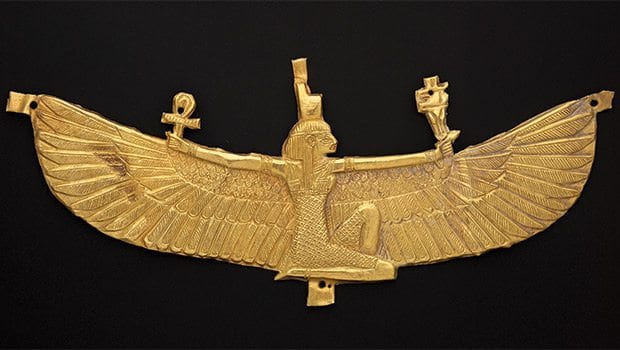

Author: Photo: Museum of Fine Arts, Boston/Harvard University—Boston Museum of Fine Arts ExpeditionMask of Queen Malakaye
The Museum of Fine Arts, Boston boasts the most comprehensive collection of Nubian jewelry and adornments outside of Khartoum. In “Gold and the Gods: Jewels of Ancient Nubia,” showing through January 8, visitors can examine these exquisite works up close.
Many of the 95 pieces displayed in “Gold and the Gods” depict objects of worship. One gold and enamel bracelet, circa 250-100 B.C., depicts Hathor, the goddess of love. Wearing a piece like this was thought to bring the benefits of romantic love into your life. Think of it as the B.C. equivalent of a positive horoscope.
The history of Nubia, a neighbor of Egypt in what is present-day Sudan, can be traced from 2000 B.C. onward in successive cultural iterations. Over two millennia, the region developed a specific set of aesthetics and became known for fine craftsmanship. As with many cultures, jewelry was a way to express the opulence and status of the upper class. But Nubians also believed that jewelry could ensure resurrection, repel evil spirits and procure the protection of the gods.

Author: Photo: Museum of Fine Arts, Boston/Harvard University—Boston Museum of Fine Arts Expedition(l-r): Amulet of Maat, pendant with ram-headed sphinx, amulet of Hathor nursing a queen.
Golden legacy
The MFA’s impressive collection stems from a joint excavation of Kurshite royal cemeteries carried out with Harvard University between 1913 and 1932. Prior to this research, little was known about the civilization. Many of the exhibited pieces are made of gold, a sacred substance associated in both Egypt and Nubia with the powerful sun god, Amen-Re. Scholars suggest that the name Nubia derives from the Egyptian word ‘nbw,’ meaning gold.
The works are remarkably contemporary in style, proving that fashion is not only cyclical, it’s several thousand years repeated. An ornate, gilt crown of flowers sits displayed among the religious pieces. Flower crowns remain wildly popular on the modern-day music festival circuit, though the $12 Forever21 creations are decidedly less elegant and artistic than the Nubian versions.

Author: Photo: Museum of Fine Arts, Boston/Harvard University—Boston Museum of Fine Arts ExpeditionA Nubian signet ring.
Fine detail
It’s astounding to see minute details carved into rings and bracelets with rudimentary tools. “Winged Isis Pectoral” measures only a few inches yet depicts individual feathers on the wingspan of the Nubian goddess Isis. In addition to gold jewelry, Nubian craftsmen were known for their excellence in glassmaking, a new art form at the time. In order to create glass beads for apparel, the maker s applied drops of molten glass onto the body of a heat-softened glass bead and then pressed the drop into the matrix. Each bead took hours to make.
While we’re inundated with information about Egypt, “Gold and the Gods” offers a unique window into a lesser-known culture. Beyond the aesthetics of the upper class, the items on display illustrate the religion, craftsmanship and social hierarchy of a mysterious, ancient social order.







